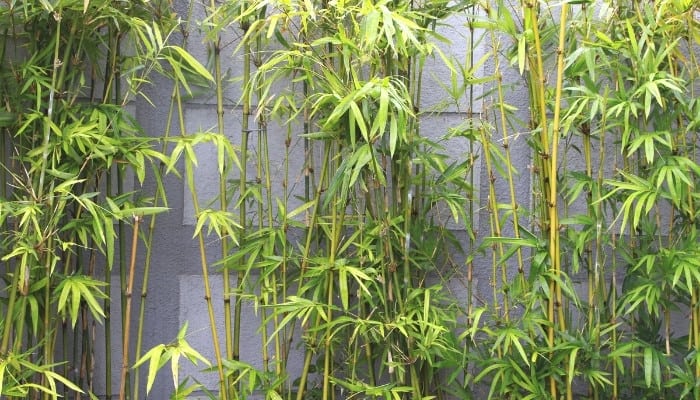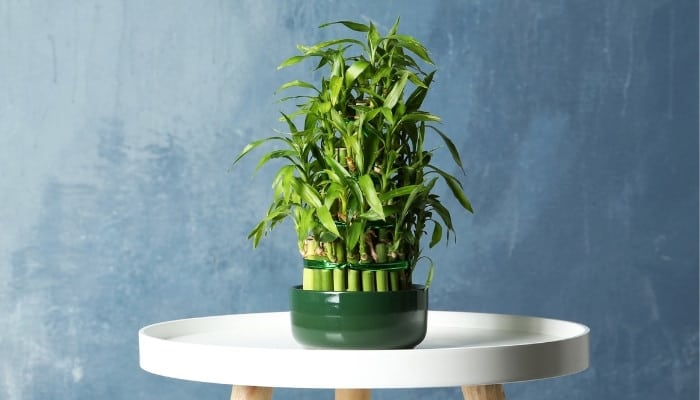If you’ve ever been to a zoo, nature reserve, or botanical garden, you may have observed the lush, jungle-like appearance of the simple bamboo plant.
The bamboo plant can grow more than 5 feet each year if provided with the right growing conditions.
This fast-growing tropical plant is a gorgeous addition to the garden and home, especially if you want that chic, trendy jungle-type ambiance.
With over 1,000 species to choose from, the bamboo plant certainly provides indoor and outdoor plant lovers with more than enough choice!
Are bamboo plants easy to grow? Bamboo is quite easy to grow both indoors and outside. These plants prefer a slightly acidic, loose soil and frequent light watering. At least 4-6 hours of bright light is required for optimum growth. A slow-release fertilizer may be applied twice per year to encourage continued growth.
If you are looking to transform your indoor space into a tropical haven or perhaps you just want to add a splash of jungle charm to your living room, you are in the right place.
Read on to discover how to grow bamboo plants with ease.
Easy Care Guide for Growing Bamboo in Pots
Like all plants, the bamboo plant requires a certain level of care to encourage healthy growth.
Heat, light, and moisture are the three key factors that will promote a thriving bamboo plant. So, let’s delve a little deeper.
Pots and Soil for Bamboo
Bamboo is classified into two types: “running” and “clumping.”
The clumping variety grows slower while the running variety spreads quickly, often invading open areas.
Growing bamboo in pots is an excellent idea to prevent the possibility of dealing with out-of-control growth and spread.
Choose a suitable pot with sufficient drainage holes to prevent soil from becoming waterlogged; it should also have adequate space for the bamboo plant’s roots.
A good size container to use would be between 18-30 inches deep and wide. Add a layer of pebbles followed by a layer of sand to the base of the container to improve drainage.
Although the bamboo plant is happy to grow in most soils, use a good potting mix if you want bushy green foliage and healthy, fast-growing bamboo.
If you mix your own potting soil, use equal parts of soil, peat moss, and perlite. Bamboo prefers slightly acidic soil with a pH of 6.5 -7.
Watering Bamboo
Bamboo plants love moisture, but an overwatered bamboo plant will quickly start to display signs of distress.
Yellowing leaves and root rot are common side effects of a heavy-handed watering can.
With bamboo, the key is little and often; water two to three times a week and allow the top layer of soil to dry in between each watering session.
Then, use your finger to test that the soil is dry to a depth of 2 inches before applying the next soaking.
Ideal Lighting, Temperature & Humidity for Indoor Bamboo
Indoor bamboo needs a little more attention when it comes to heat, light, and humidity.
This is because our homes vary in temperature and are often darker and dryer than the bamboo plant’s natural environment.
Position the plant so it receives at least 4-6 hours of bright direct light each day. Low lighting levels can affect the bamboo plant’s growth rate.
Room temperature is excellent for indoor bamboo plants; however, indoor warmth leads to dry air and reduced humidity levels.
Because the bamboo plant absorbs its moisture through the soil and the surrounding environment, it requires some humidity to grow.
Therefore to increase humidity levels, mist the bamboo plant each day.
You can also place it near a humidifier (check out this ultra-quiet model) or on a pebble tray filled with water (here is how to easily make your own).
Fertilizing Bamboo in Pots
Due to its vigorous growth, the bamboo plant requires fertilizing twice a year.
Use a slow-release, balanced fertilizer, like this one that’s guaranteed not to burn your plants.
Feed in the spring to promote new growth and again in the middle of summer to replace depleted nutrients.
Head over to this article to discover the best types of bamboo for indoor growing.
Growing Bamboo in Water
Growing bamboo hydroponically is pretty simple and so much easier than using soil and large containers.
It’s a superb and decorative way of adding a touch of color to any room in the house.
- First, select a shoot that has at least two nodes on the stem.
- Then place the cutting in a clean jar of fresh distilled water. Alternatively, allow tap water to stand for 24 hours so the chlorine can dissipate.
- Add pebbles to the jar of water to support the plant stem; the stem must be kept upright.
- Position the cutting in partial shade; it should take one to two months to develop roots.
- Ensure the water always covers roots. Change the water once weekly to prevent the plant and roots from rotting, making sure to rinse the container thoroughly.
Caring for Outdoor Bamboo

Outdoor bamboo creates a lovely exotic flavor to any garden.
Position in full sun or partial shade to encourage foliage development. Ensure the soil is light and airy to promote root growth.
Water deeply each week with at least 2-2.5 centimeters of water to encourage a deep, stable root system that will protect your plants during periods of drought.
Fallen bamboo leaves provide nutrients to the soil and provide a protective layer promoting soil moisture.
Provide a layer of mulch and compost in early spring to keep your bamboo thriving throughout the summer months.
Related Questions:
How Long Can Bamboo Live in Pots?
You can grow bamboo in pots for an indefinite period if you continue to provide the correct light, heat, water, and humidity levels.
However, you may need to repot at least once a year to prevent the plant from becoming rootbound and dying because of its fast growth rate.
Will Bamboo Survive Winter in Pots?
Certain types of bamboo can tolerate colder temperatures; check the plant information on the label to determine if your bamboo is cold hardy.
Outdoor container soil freezes faster than the open ground; therefore, bamboo grown in containers will struggle with cold or frozen roots.
Move the bamboo into a shed, greenhouse, or garage to protect the bamboo from freezing temperatures, but move back into the light once the cold snap has passed.
Conclusion
This hardy yet versatile plant is an excellent investment to your plant family because it grows well and is extremely easy to maintain.
Although many gardeners grow bamboo as a filler or screen in the outdoor garden, indoor green thumbs worldwide can also enjoy its exotic foliage.
In addition to being highly decorative, the bamboo plant is a natural air purifier promoting healthy, clean air in the home.
That’s beauty and health all in one plant!

